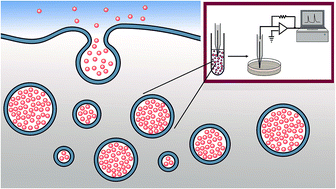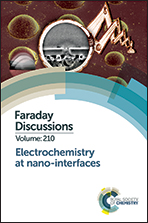Electrochemical quantification of transmitter concentration in single nanoscale vesicles isolated from PC12 cells†
Abstract
We use an electrochemical platform, nanoparticle tracking analysis, and differential centrifugation of single catecholamine vesicles to study the properties of nanometer transmitter vesicles, including the number of molecules, size, and catecholamine concentration inside. Vesicle impact electrochemical cytometry (VIEC) was used to quantify the catecholamine content of single vesicles in different batches isolated from pheochromocytoma (PC12) cells with different ultracentrifugation speeds. We show that, vesicles containing less catecholamine are obtained at subsequent centrifugation steps with higher speed (force). Important to quantification, the cumulative content after subsequent centrifugation steps is equivalent to that of one-step centrifugation at the highest speed, 70 000g. Moreover, as we count molecules in the vesicles, we compared molecular numbers from VIEC, flow VIEC, and intracellular VIEC to corresponding vesicle size measured by nanoparticle tracking analysis to evaluate catecholamine concentration in vesicles. The data suggest that vesicular catecholamine concentration is relatively constant and independent of the vesicular size, indicating vesicular transmitter content as a main factor regulating the vesicle size.

- This article is part of the themed collection: Electrochemistry at nano-interfaces


 Please wait while we load your content...
Please wait while we load your content...